Magic is Important
Writer and West Bank Social Center co-founder Miranda Trimmier reflects on the recent retrospective of the Parisian art space, castillo/corrales, at Midway Contemporary Art, and on the necessarily slippery nature of experimental art spaces.
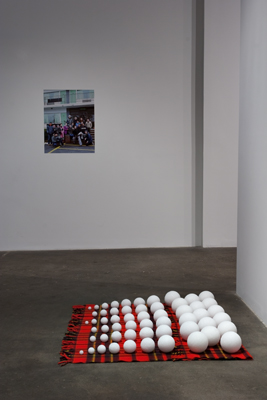

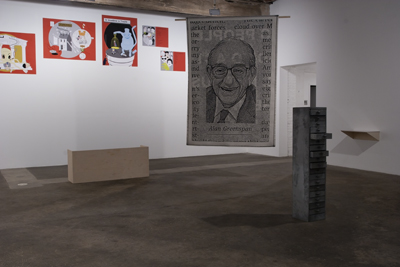
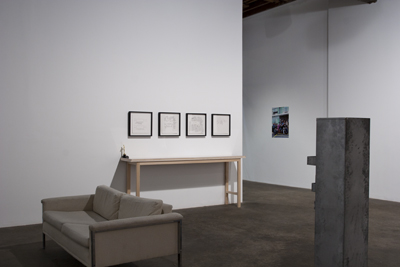
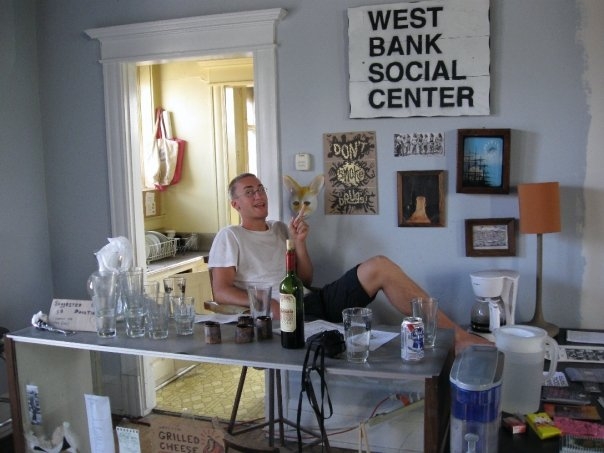
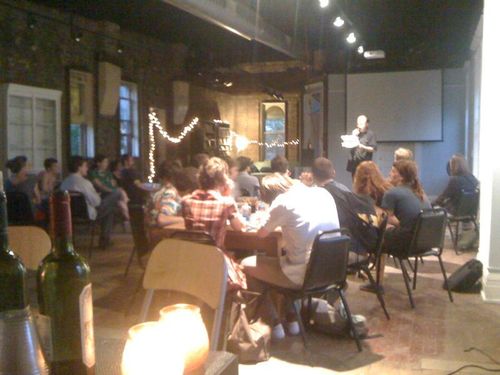
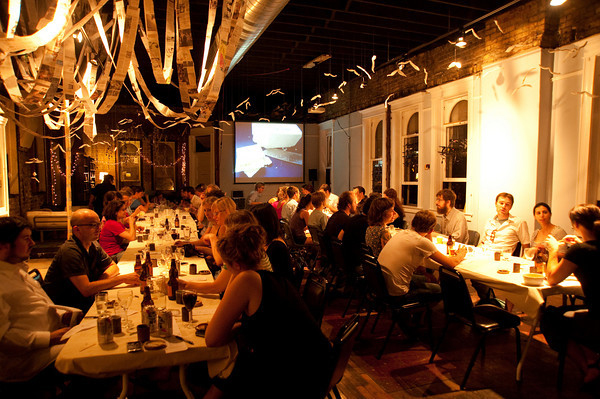
THE FIRST THING YOU SAW AS YOU ENTERED THE WEST BANK SOCIAL CENTER was the display case, in all its scrappy, jerry-rigged glory — gold paint peeling, glass panels cracked and duct-taped together, shelves piled high with stuff. The case was supposed to be a miniature gallery, a spot for tiny themed shows and collections of curiosities, but as time passed we began just to stash things there. Like a very public junk drawer, our clutter was exposed to anyone who happened through: tiny plates and bird masks, votive candles, wristbands, playing cards and little pen portraits, stray condoms and plastic wine cups. Soon enough, we stopped trying to keep the case neat because, well, its disarray felt apt. Our entire tenure as a public space had been untidy. Depending on our mood, my co-founders and I called WBSC an art space, or a gathering spot, or a laboratory. And depending on the day, our fluctuating explanations seemed more or less appropriate. Our project was, first and foremost, an experiment.
And experiments are messy. This insight featured heavily in Midway Contemporary Art’s recently-completed show, castillo/corrales‘ sort-of-retrospective The Way It Wasn’t (Celebrating ten years of castillo/corrales, Paris). The Way It Wasn’t looked to me like a more formal version of our display case: an accumulation of thoughts and things, plunked together unceremoniously and without explanation. Gallery-goers could peruse the exhibition’s budget projections, art pieces, inkjet preview printouts, books, and other bits of ephemera, and see the messy leftovers of one experimental Parisian art space’s day-to-day doings. If these visitors were like me, they might not have known what to do with it all. And maybe they weren’t meant to: the show’s only written supplement, its web preview, lampooned the traditional retrospective’s tendency to give “an illusion of coherence” to bodies of work that are in reality more like the contents of the West Bank Social Center’s case, or the contents of The Way It Wasn’t — that is, at least a little like a pile of junk.
Yet the presence of an exhibition like The Way It Wasn’t at Midway reflects the fact that spaces like castillo/corrales, or like the West Bank Social Center, have — coherent or not — become quite sexy. We call them experimental, or alternative, or independent; but whichever euphemism we choose, these ad-hoc art spaces have captured our attention. Audiences flock to them, arts publications scramble to cover them, museums hustle to collaborate with them, and critics hem and haw about what, exactly, might be going on. And we are still figuring that out, it seems.
At the opening discussion for The Way It Wasn’t, panel members — curators from a few prominent experimental spaces, including castillo/corrales — lingered on a deceptively simple question: What makes a space experimental, alternative, or independent? These words encompass a fairly breathtaking range of spaces, after all, from temporary home shows and tiny storefront organizations to established non-profits and high-profile galleries. Such words somehow describe both castillo/corrales — an internationally-known space run by established artists and critics, one courted by institutions like the Tate Modern; and the West Bank Social Center — a short-lived[1], informal social experiment that only occasionally had anything to do with art. Last year, the online journal Quodlibetica published an issue dedicated to Twin Cities alternative art spaces that placed profiles of Art of This, SooVAC, Midway, and They Won’t Find Us Here next to one another — strange bedfellows, indeed. And yet even if we can’t express why, exactly, there is something intuitive in the ways we lump these disparate sorts of places together.
How could we begin to describe this murky web of connections? A recent article in the Twin Cities Daily Planet on another local alternative art space, 1419, offers one place to start. The article’s author, Sheila Regan, caught 1419 in a moment of tension and growth, “a crossroads,” in her estimation. And while some of this tension stemmed from the inevitable pragmatic concerns of simply running a public space — how to remain fiscally sustainable, say, or how to manage a rapidly expanding group of organizers and collaborators — much of the stress seemed theoretical, rooted in more abstract concerns. “There’s an implicit tug-of-war,” one organizer told Regan, “about what the 1419 identity means.” This identity had been built around fluid words — experimental, interdisciplinary, expansive, non-structured[2] — and an equal-opportunity attitude towards programming that has brought sound installations, puppet shows, sports games, potlucks, lectures, and dance parties to the space. As 1419 has grown, though, some members have pushed for greater structure and definition, both in terms of organizational practices and the mission communicated to the public. Others have resisted this path of development, wary of compromising the freedom they’ve enjoyed until now.
______________________________________________________
Perhaps these spaces are striving, in a cultural climate filled with demands to explain, to carve out a niche where they don’t have to, because they’ve found creative freedom in the borderlands outside definition.
______________________________________________________
I’d like to pause here to think more about this tension and this wariness. When I first began composing this essay, I wrote to some veterans of local alternative art spaces that I know, asking them how they describe their experiments, how they talk to others about the work they’ve done. Their responses were instructive. One colleague suggested that he’d require, to capture the full complexity of his project, an elaborate pop-up book, with architectural fold-outs and trap doors and little hanging balloons. Another insisted, though she’d been involved in several such spaces, that she had little insight to offer. Still another avoided explanation more directly, telling me that “too many facts kill the magic,” and that “magic,” after all, “is important.”
In short, their answers were coy. In their own ways, my respondents were each — like the organizers of 1419 and castillo/corrales, like me and my colleagues at the West Bank Social Center — hesitant to say too much about their spaces or give their work an easy “illusion of coherence.” This reluctance may provide one good answer to The Way It Wasn’t panel’s question. Perhaps one thing these experimental projects share is a skeptical relationship to self-definition: a lack of interest in articulating a fixed identity, a distrust of mission statements and didactics and ever-present promotional cycles. Perhaps these spaces are striving, in a cultural climate filled with demands to explain, to carve out a niche where they don’t have to, because they’ve found creative freedom in the borderlands outside definition. Perhaps we’re drawn to such experiments precisely because the organizers aren’t the only ones who crave a bit of ambiguity; maybe we appreciate spaces that allow us to encounter interesting work and ideas without a lot of mediating chatter, even (or especially) if that lack makes things messy.
Of course, this ambiguity is tough to maintain. As these spaces grow and flourish, they will inevitably be asked to explain themselves — to funders, to critics, to journalists, to audiences. It’s impossible to remain outside definition forever. But for the projects that care enough about preserving an open-ended space in which to work, the castillo/corrales “retrospective” offered another useful lesson, one I haven’t yet mentioned and one on which I’d like to linger for a moment. This lesson is hinted at in the exhibition title, and elaborated upon in little moves throughout the show: the ironic, tongue-in-cheek tone of its preview; the inclusion of pieces that were never actually exhibited at castillo/corrales (according to the preview: “Some were only discussed but got postponed. For others, it just wasn’t the right time.”); the display of several years’ worth of budget goals and projections; the gap between the supposed occasion of the show, a ten-year retrospective, and a biographical note (also in the preview) that placed castillo/corrales’ founding date four years ago. The Way It Wasn’t didn’t simply present an unofficial history, an unedited pile of junk, although that was part of the effect. The show also joked and supplemented and speculated; it took pleasure in embellishments and lies. That is to say, the show operated in a handful of registers that exceeded its factual one, and in the process multiplied the stories one could tell about the castillo/corrales space.
In the end, that seems to be the real point of The Way It Wasn’t: to play with facts in ways that produce, in castillo/corrales’ words, “more than there actually is.” And maybe, in his own way, that is what my friend was dreaming about when he described his sprawling pop-up book memoir. Ambiguity need not be mushy, a passive reaction to oversimplified narratives about complicated creative practices. It can also be an active, productive strategy — one spun out of half-truths and hopes and bits of winking bullshit, marshaled purposefully to keep too many facts from killing the magic. That strategy takes time and thought, but for those spaces where magic is important, the work may well be worth it.
______________________________________________________
About the author: Miranda Trimmier spends a lot of time reading, writing, and making things. She believes very earnestly that magic is important, and thanks a special nameless friend for the reminder.
______________________________________________________
Noted exhibition details:
The Way it Wasn’t (Celebrating 10 Years of castillo/corrales, Paris) was on view at Midway Contemporary Art in Minneapolis from November 20, 2010 – January 15, 2011.
[1] WBSC is not technically closed, but it no longer operates as a full-time project. It has been absorbed into the 1419 space, although two of my co-founders still occasionally run programs under the WBSC name.
[2] The italicized words were either used by 1419 organizers and quoted in the noted article or culled directly from the 1419 website.